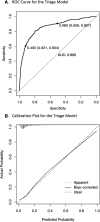Smart triage: Development of a rapid pediatric triage algorithm for use in low-and-middle income countries
- PMID: 36483471
- PMCID: PMC9723221
- DOI: 10.3389/fped.2022.976870
Smart triage: Development of a rapid pediatric triage algorithm for use in low-and-middle income countries
Abstract
Introduction: Early and accurate recognition of children at risk of progressing to critical illness could contribute to improved patient outcomes and resource allocation. In resource limited settings digital triage tools can support decision making and improve healthcare delivery. We developed a model for rapid identification of critically ill children at triage.
Methods: This was a prospective cohort study of acutely ill children presenting at Jinja Regional Referral Hospital in Eastern Uganda. Variables collected in the emergency department informed the development of a logistic model based on hospital admission using bootstrap stepwise regression. Low and high-risk thresholds for 90% minimum sensitivity and specificity, respectively generated three risk level categories. Performance was assessed using receiver operating characteristic curve analysis on a held-out test set generated by an 80:20 split with 10-fold cross validation. A risk stratification table informed clinical interpretation.
Results: The model derivation cohort included 1,612 participants, with an admission rate of approximately 23%. The majority of admitted patients were under five years old and presenting with sepsis, malaria, or pneumonia. A 9-predictor triage model was derived: logit (p) = -32.888 + (0.252, square root of age) + (0.016, heart rate) + (0.819, temperature) + (-0.022, mid-upper arm circumference) + (0.048 transformed oxygen saturation) + (1.793, parent concern) + (1.012, difficulty breathing) + (1.814, oedema) + (1.506, pallor). The model afforded good discrimination, calibration, and risk stratification at the selected thresholds of 8% and 40%.
Conclusion: In a low income, pediatric population, we developed a nine variable triage model with high sensitivity and specificity to predict who should be admitted. The triage model can be integrated into any digital platform and used with minimal training to guide rapid identification of critically ill children at first contact. External validation and clinical implementation are in progress.
Keywords: children; logistic regression; low-and-middle income countries; model; prediction; sepsis; triage.
© 2022 Mawji, Li, Dunsmuir, Komugisha, Novakowski, Wiens, Vesuvius, Kissoon and Ansermino.
Conflict of interest statement
NK serves as a Specialty Chief Editor for Frontiers in Pediatrics. The peer-review process was guided by an independent editor, and the authors have no other competing interests to declare.
Figures


Similar articles
-
Derivation and internal validation of a data-driven prediction model to guide frontline health workers in triaging children under-five in Nairobi, Kenya.Wellcome Open Res. 2021 Apr 19;4:121. doi: 10.12688/wellcomeopenres.15387.3. eCollection 2019. Wellcome Open Res. 2021. PMID: 33997296 Free PMC article.
-
Cost-effectiveness analysis protocol of the Smart Triage program: A point-of-care digital triage platform for pediatric sepsis in Eastern Uganda.PLoS One. 2021 Nov 17;16(11):e0260044. doi: 10.1371/journal.pone.0260044. eCollection 2021. PLoS One. 2021. PMID: 34788338 Free PMC article.
-
LMIC-PRIEST: Derivation and validation of a clinical severity score for acutely ill adults with suspected COVID-19 in a middle-income setting.medRxiv [Preprint]. 2022 Nov 7:2022.11.06.22281986. doi: 10.1101/2022.11.06.22281986. medRxiv. 2022. Update in: PLoS One. 2021 Jan 22;16(1):e0245840. doi: 10.1371/journal.pone.0245840. PMID: 36380752 Free PMC article. Updated. Preprint.
-
Smart triage: triage and management of sepsis in children using the point-of-care Pediatric Rapid Sepsis Trigger (PRST) tool.BMC Health Serv Res. 2020 Jun 3;20(1):493. doi: 10.1186/s12913-020-05344-w. BMC Health Serv Res. 2020. PMID: 32493319 Free PMC article. Clinical Trial.
-
A Machine Learning Approach to Predicting Need for Hospitalization for Pediatric Asthma Exacerbation at the Time of Emergency Department Triage.Acad Emerg Med. 2018 Dec;25(12):1463-1470. doi: 10.1111/acem.13655. Epub 2018 Nov 29. Acad Emerg Med. 2018. PMID: 30382605
Cited by
-
Comparison between the Smart Triage model and the Emergency Triage Assessment and Treatment guidelines in triaging children presenting to the emergency departments of two public hospitals in Kenya.PLOS Digit Health. 2024 Aug 1;3(8):e0000408. doi: 10.1371/journal.pdig.0000408. eCollection 2024 Aug. PLOS Digit Health. 2024. PMID: 39088404 Free PMC article.
-
A scoping review on pediatric sepsis prediction technologies in healthcare.NPJ Digit Med. 2024 Dec 4;7(1):353. doi: 10.1038/s41746-024-01361-9. NPJ Digit Med. 2024. PMID: 39633080 Free PMC article.
-
Implementation of Smart Triage combined with a quality improvement program for children presenting to facilities in Kenya and Uganda: An interrupted time series analysis.PLOS Digit Health. 2025 Mar 10;4(3):e0000466. doi: 10.1371/journal.pdig.0000466. eCollection 2025 Mar. PLOS Digit Health. 2025. PMID: 40063663 Free PMC article.
-
Geographical validation of the Smart Triage Model by age group.PLOS Digit Health. 2024 Jul 1;3(7):e0000311. doi: 10.1371/journal.pdig.0000311. eCollection 2024 Jul. PLOS Digit Health. 2024. PMID: 38949998 Free PMC article.
-
Repeatability of Pulse Oximetry Measurements in Children During Triage in 2 Ugandan Hospitals.Glob Health Sci Pract. 2023 Aug 28;11(4):e2200544. doi: 10.9745/GHSP-D-22-00544. Print 2023 Aug 28. Glob Health Sci Pract. 2023. PMID: 37640488 Free PMC article.
References
-
- World Health Organization. Children: improving survival and well-being. (2020). Available at: https://www.who.int/news-room/fact-sheets/detail/children-reducing-morta... (cited April 1, 2021).
-
- Dekker-Boersema J, Hector J, Jefferys LF, Binamo C, Camilo D, Muganga G, et al. Triage conducted by lay-staff and emergency training reduces paediatric mortality in the emergency department of a rural hospital in northern Mozambique. Afr J Emerg Med. (2019) 9(4):172–6. 10.1016/j.afjem.2019.05.005 - DOI - PMC - PubMed
LinkOut - more resources
Full Text Sources

